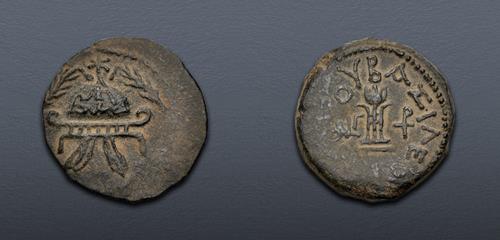|
JUDAEA. Herod I. 40-4 BCE. Æ 4 Prutot (22mm, 5.78 g, 1h). Samaria mint(?). Dated RY 3 (37 BCE). Military helmet in frontal view with cheek pieces and straps, decorated with acanthus; above, star above flanked by palm branches / [ΗΡΩ]ΔΟΥ ΒΑΣΙΛΕ[ΩΣ], tripod; ceremonial bowl (lebes) above, flanked by LΓ (date) and monogram. Hendin 6204; TJC 44; RPC I 4901 . Lightly dusted, even green surfaces, minor areas of weak strike. Good VF.
From the David Hendin Collection, sold for the benefit of the American Numismatic Society.
Lasting from roughly 40 BCE to CE 95, the Herodian dynasty of Judaea was established by Herod I, a vassal ruler of the Roman Empire. Born to an assimilated Jewish Idumenean family and advisors to the Hasmonean dynasty, Herod was declared king in 40 BCE by the Roman Senate and the Triumvirate under Mark Antony, and later by Augustus (though it would not be until 37 BCE that Herod would actually possess a kingdom). Herod was a jealous, polarizing ruler particularly notable for his historical proximity to the life of Jesus, and is mentioned numerous times in the Bible: “...Jesus was born in Bethlehem of Judaea in the days of Herod the king…” (Matthew 2:1). As David Hendin writes, “While Herod was undeniably Jewish, he was less popular with Jews than with the Romans. Inside his own nation, Herod was considered cruel, vengeful, and power-hungry.” He oversaw enormous public works projects during his reign, more than doubling the size of the Temple Mount and renovating the Second Temple. Furthermore, as Hendin continues, “Members of the dynasty Herod founded became official and unofficial spokesmen for the Jewish people not only in their kingdom, but throughout the ancient world. The influence of Herod and his descendants continued to affect decisions by the imperial court in Rome for more than a century.”
Herodian coinage, a robust and varied series in Judaean numismatics, is most notable for some of its later issues, which can be considered some of the earliest Roman provincial coinage in Judaea. One coin, struck under Agrippa I, goes so far as to depict Agrippa and Herod of Chalcis crowning Claudius with a wreath as a translated legend reads “A vow and treaty of friendship and alliance between the Great King Agrippa and Augustus Caesar, the Senate and the People of Rome.” Due to its importance in the history of Roman provincial coinage, some coinage of the later dynasts in the Herodian line will be made available in the Roman provincial portion of this auction.
Closing Date and Time: 18 January 2023 at 10:35:00 ET.
Winning bids are subject to a 22.5% buyer's fee for bids placed on this website, 25% for all others.
|
